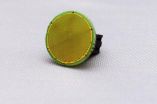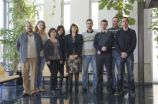(Press-News.org) Researchers from the Polytechnic University of Catalonia have developed a technique that improves and cuts the cost of a technique called electroporation, which involves opening pores in cell membranes using an electric field to introduce substances like drugs and DNA. Current methods are aggressive and expensive whereas the new system manages to apply low voltage electroporation with a small printed circuit board, which costs less than a Euro per unit and does not damage cells.
Two US firms in Boston and San Francisco operating in the biotechnology equipment sector have already expressed their interest in the new system for the electroporation of cell cultures developed and patented by researchers at the Biomedical Engineering Research Centre (CREB) of the Polytechnic University of Catalonia (UPC).
Electroporation consists of opening the pores in the cell membranes using an external electric field to insert certain substances such as drugs, DNA and RNA. It is used for example in gene therapies and molecular biology experimentation. "Until now, its use has been rather restricted because current systems are expensive and awkward," as explained to SINC by the researcher Ramón Bragós who undertook this project along with PhD student Tomás García-Sánchez.
Different electroporation techniques are used for example in the process of inserting exogenous nucleic acids into eukaryotic cells. This process is called transfection and in 2012 it generated a global turnover of 650 million euros, according to data from the UPC.
Bragós outlines that the electroporation system developed by the UPC simplifies that process and reduces many of the costs compared to techniques being used at present. This makes its use in research easier.
The UPC's system can be applied in the electroporation of mammal cell cultures. As the researcher explains, in this case cells grow adherent to the bottom of plates. "These cells are 'accustomed' to being in a tissue, in a compact environment where they touch their neighbours. When they are cultivated they stick to the bottom and grow until they come in contact with other cells thus forming a monolayer," adds the researcher.
Avoiding cell stress
According to Bragós, the electroporation method used up to now is very aggressive. Firstly, an enzyme must be added to detach the cells adhered to the bottom of the culture plate. Then they must be transferred to a special cuvette with electrodes where the electrical discharge is applied. Lastly, the cells must then be returned to the plate. All this combined causes stress in the cells and only a fraction survives. This translates into significant losses.
"We have developed a small plate in the shape of a disk. In its lower face it contains a collection of electrodes that allow for high output electroporation. The devices are made to match the size of the plate containing the cultures, the most common being a centimetre in diameter."
Ramón Bragós explains that the added value of the device is that it allows the electroporation in the recipient in which cell culture is already taking place without the need for them to be extracted. This usually occurs in Petri dishes or multiwell plates. The device incorporates microseparations that ensure that the disk is situated some 10 microns apart. Therefore, without touching or crushing the cells the discharge is performed under 20 volts and then removed.
"We initially thought of developing a device with microelectronic technology but we managed to do it with printed circuit technology, which is much cheaper. Each disk ends up costing less than one Euro per unit, which is very competitive compared to current devices that go from one Euro to 100 euros per unit," points out the researcher.
In addition, Bragós points out that the low cost of the new devices means that laboratories can use them on a single use basis. This eliminates culture contamination problems.
The technique is also safer for those carrying out the experiments thanks to its low discharge of less than 20 volts compared to conventional techniques that can use up to hundreds or even thousands of volts, according to the researcher.
This project was financed through Catalonia's Technology Assessment Support Programme of the Generalitat's Agencia ACC1Ó.
In addition, the initiative enjoyed the active participation of the group lead by Dr Anna Maria Gómez-Foix from the Department of Biochemistry and Molecular Biology of the University of Barcelona.
Experimentation with small RNA fragments
The PhD student Tomás García-Sánchez has played a fundamental role in developing the new technique applied to the UPC's electroporation of cultures and is currently writing his thesis on this project.
García-Sánchez explains to SINC that during the process of developing the new system they experimented with a transfection technique based on inserting small RNA fragments into the siRNA (small interfering RNA) culture cells. The main function of these fragments is to block specific gene expression once inserted into the cellular cytoplasm.
"The possible gene therapy with siRNA is on the rise in the world of biomedical research nowadays with its application in antiviral therapies and neurodegenerative illnesses, for example," indicates the researcher.
"The fact that we have managed to simplify and make the electroporation process cheaper has opened the door for molecular biology researchers to access a technique with many prospects," he concludes.
INFORMATION:
References:
Tomás García-Sánchez, Beatriz Sánchez-Ortiz , Ingrid Vila, Maria Guitart, Javier Rosell, Anna M. Gómez-Foix, Ramón Bragós. "Design and Implementation of a Microelectrode Assembly for Use on Noncontact In Situ Electroporation of Adherent Cells". Journal of Membrane Biology. 2012; 245(10):617-24. DOI 10.1007/s00232-012-9474-y
Tomás García-Sánchez, Maria Guitart, Javier Rosell IEEE, Anna M. Gómez-Foix, Ramón Bragós. "Automatic system for electroporation of adherent cells growing in standard multi-well plates". 34th Annual International Conference of the IEEE EMBS. San Diego, California EE UU. 2012
A Spanish breakthrough allows the electroporation of cell cultures for less than 1 Euro
2013-02-07
ELSE PRESS RELEASES FROM THIS DATE:
Asians are far more likely than Anglos to be college-educated
2013-02-07
Asians (about 60 percent) are much more likely to be college-educated than Anglos (under 40 percent), according to Rice University's Kinder Institute Houston Area Asian Survey, the first systematic look at the local Asian population based on three surveys conducted over a 16-year period. The findings were released today by Stephen Klineberg, Kinder Institute co-director and Rice sociologist, at an event hosted by the institute at the Asia Society Texas Center.
The surveys, conducted in 1995, 2002 and 2011 in conjunction with the annual Kinder Institute Houston Area Survey, ...
Research could ensure that crowd work becomes a career option, not a dead end
2013-02-07
PITTSBURGH—Crowdsourcing is an effective way to mobilize people to accomplish tasks on a global scale, but some researchers fear that crowd work for pay could easily become the high-tech equivalent of a sweat shop. Trivial work for rock bottom pay isn't inevitable, however, and they've outlined a research agenda to make crowd work both intellectually and monetarily rewarding.
Leading researchers in crowd work from Carnegie Mellon University and other institutions will present their plan, hashed out in a special workshop last spring, at the Association for Computing Machinery's ...
Veterans with mild traumatic brain injury have brain abnormalities
2013-02-07
Mild traumatic brain injury (TBI), including concussion, is one of the most common types of neurological disorder, affecting approximately 1.3 million Americans annually. It has received more attention recently because of its frequency and impact among two groups of patients: professional athletes, especially football players; and soldiers returning from mid-east conflicts with blast-related TBI. An estimated 10 to 20 percent of the more than 2 million U.S. soldiers deployed in Iraq or Afghanistan have experienced TBI.
A recent study by psychiatrists with the Iowa City ...
A privacy risk in your DNA
2013-02-07
The growing ease of DNA sequencing has led to enormous advancements in the scientific field. Through extensive networked databases, researchers can access genetic information to gain valuable knowledge about causative and preventative factors for disease, and identify new targets for future treatments. But the wider availability of such information also has a significant downside — the risk of revealing personal information.
Researchers from Tel Aviv University and the Whitehead Institute of Biomedical Research in Cambridge, MA, have developed an algorithm that can identify ...
UAB researchers cure type 1 diabetes in dogs
2013-02-07
Researchers from the Universitat Autònoma de Barcelona (UAB), led by Fàtima Bosch, have shown for the first time that it is possible to cure diabetes in large animals with a single session of gene therapy. As published this week in Diabetes, the principal journal for research on the disease, after a single gene therapy session, the dogs recover their health and no longer show symptoms of the disease. In some cases, monitoring continued for over four years, with no recurrence of symptoms.
The therapy is minimally invasive. It consists of a single session of various injections ...
Key protein revealed as trigger for stem cell development
2013-02-07
A natural trigger that enables stem cells to become any cell-type in the body has been discovered by scientists.
Researchers have identified a protein that kick-starts the process by which stem cells can develop to into different cells in the body, for instance liver or brain cells.
Their discovery could help scientists improve techniques enabling them to turn stem cells into other cell types in the laboratory. These could then be used to test drugs or help create therapies for degenerative conditions such as Parkinson's disease, motor neurone disease, multiple sclerosis ...
How a fall in duck hunting is shooting a financial hole into conservation efforts
2013-02-07
The annual duck hunting season in the United States is traditionally big business, but while bird numbers are rising faster than they have for decades, the number of hunters continues to fall. Far from being good news for ducks a new study in the Wildlife Society Bulletin shows how the loss of revenue from 'duck stamps' could result in millions of lost dollars for vital conservation work.
"The last 15 years have brought hunting opportunities not seen since the turn of the last century," said Dr Mark Vrtiska from Nebraska Game and Parks Commission. "The waterfowl population ...
Information Technology improves patient care and increases privacy, MU informatics expert says
2013-02-07
The federal government invested more than $25 billion in health information technology (IT) as a result of the American Reinvestment and Recovery Act; yet, little is known about how IT applications improve patient safety and protect their privacy. Now, a University of Missouri nursing informatics expert suggests that sophisticated IT leads to more robust and integrated communication strategies among clinical staff, which allows staff to more efficiently coordinate care and better protect patient privacy.
Greg Alexander, an associate professor in the MU Sinclair School ...
Waste dump at the end of the world
2013-02-07
This press release is available in German.
(Jena) On their mission to the moon in 1969 the Americans Neil Armstrong and Buzz Aldrin created arguably the most famous footprints ever. Since the time the astronauts of the Apollo 11 Mission stepped onto the surface of our satellite their footprints remain almost unchanged. And as no breath of wind will ever be able to blow them away they will be visible forever.
Not quite so old but equally 'immortal' are many traces that have been left behind by humans at the South Pole of the Earth. This is the result of a report ...
Lancet Oncology: Long-term side-effects of targeted therapies in pediatric cancer patients
2013-02-07
A University of Colorado Cancer Center review published this week in the journal Lancet Oncology describes possible long-term side-effects of new, targeted therapies in pediatric cancer patients: what we don't know may hurt us.
"As pediatricians who treat kids with cancer, we expect the side-effects of traditional chemotherapies: low white blood count, infections, even long-term heart trouble or infertility. But there's the impression that these new, molecularly targeted agents are much less toxic. That may be true, especially in adult patients, but until we have more ...


